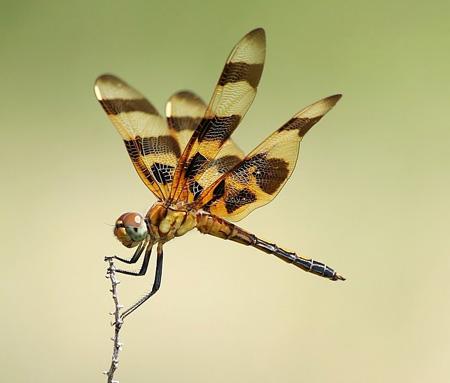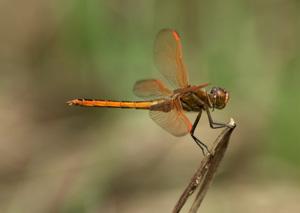Dragonflies, like most insects that appear aplenty in the summer, flourish where there’s plenty of water, sun and perches for resting their wings.

Halloween Pennant
“If you’re a dragonfly geek, this is one of the best places in the country to be,” said Kevin Munroe, manager of Huntley Meadows Park in Northern Virginia and creator of DragonfliesNVA.com.
“Some of the parks in this area may have some of the highest numbers of dragonfly species in the whole country.”
Munroe’s website reports that 83 species have been recorded in Northern Virginia. He’s counted 25 different species in one day. They range from the region’s tiny little blue dragonlet, which measures 0.75 inches, to the comet darner and dragonhunter that measure about 3.5
inches long.
Dragonflies and their cousins damselflies are found throughout the mid-Atlantic, and local and state parks with water are prime places to look for them. The Bay’s overall landscape, with marshes and shallow streams, provides ideal habitat for the predatory fliers that lay their eggs in the water.
The Bay also boasts a high concentration of “dragonfly nuts” who lead surveys, mostly at parks, throughout the region.
Jim Waggener is one of them. He leads surveys with the Audubon Society of Northern Virginia every Friday morning from April to October, when dragonfly and butterfly populations are at their peak. Through surveys each year that cover the same regions, Waggener and other volunteers have developed a picture of which dragonflies frequent the area. They focus on relatively undeveloped portions of the watershed, he said, as a good indicator of what the local wildlife might be like if the rest of the region was in a similar condition.
Since dragonflies are “solar-powered,” meaning that, like butterflies, they don’t fly far unless their wings are warmed by the sun, the best bet for spotting them is a bright day. That means most surveys don’t start at the crack of dawn, because these insects don’t take to the air until the sun does.
Waggener said those who go looking are likely to see large numbers of dragonflies throughout the summer, and “some really frantic activity” in August and September.
A field guide will do the trick for identifying most of the dragonflies, and Munroe’s website has helpful guides for distinguishing them from damselflies, which have thinner bodies for starters.
When you see a dragonfly, Munroe points out, you’re seeing “the last little blink of its life” which was otherwise spent mostly underwater as a grub. Dragonfly larvae can overwinter in the water for several years, breathing with gills like a fish and eating other larvae. The adults only live and fly for a few summer months.
If you’ve ever seen a dragonfly hovering just over the water’s surface, she was probably laying eggs with the tiny tap of her abdomen. This comes after what can be a herculean exercise in mating.
“They do something called the wheel position,” Munroe explained.
This entails the female flying both backward and upside-down while she’s connected to the male for mating, coordinating their wing beats to fly in tandem.
“When Fred Astaire and Ginger Rogers danced, she did everything backward in heels, and dragonflies are the same way,” Munroe said.
Other impressive dragonfly feats? Their wings beat about 50 times per second, and some species can fly up to 40 mph. Their “bug eyes” dwarf those of other insects and allow them to see almost 360 degrees around their heads.
And, if that weren’t enough, they’ve been known to fly across the ocean, having been spotted by sailors on boats near the midpoint.
Munroe said he uses all these facts to recruit new dragonfly enthusiasts both to the sport of spotting and to the practice of conservation.
“I want dragonflies to be the ambassadors that get them excited about wetlands like the Chesapeake Bay,” he said.
By Whitney Pipkin
..



Write a Letter to the Editor on this Article
We encourage readers to offer their point of view on this article by submitting the following form. Editing is sometimes necessary and is done at the discretion of the editorial staff.